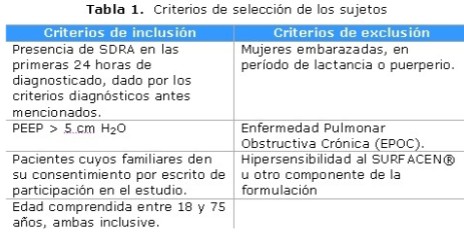Seguridad del tratamiento con surfactante pulmonar en el síndrome de dificultad respiratoria aguda en adultos
Texto completo:
PDF
Resumen
Fundamento: el síndrome de dificultad respiratoria aguda es una enfermedad nosológica asociada con una alta morbilidad y mortalidad.
Objetivo: determinar los eventos adversos asociados a la terapia con surfactante pulmonar en adultos con SDRA.
Métodos: se incluyeron 48 pacientes adultos entre 18 y 75 años con SDRA en un ensayo clínico fase II, controlado, aleatorizado y multicéntrico. El grupo A con 24 pacientes, recibió surfactante pulmonar cada ocho horas, durante tres días, en dosis de 100 mg totales, junto al tratamiento estándar (oxigenación y ventilación mecánica). El grupo B, también con 24 pacientes, recibió el tratamiento estándar. Se identificó y cuantificó la aparición de eventos adversos, así como la gravedad, seriedad y relación de causalidad con respecto al fármaco desde la inclusión del paciente en el estudio hasta el egreso de la unidad de cuidados intensivos.
Resultados: el 56, 25 % de los pacientes incluidos presentó algún evento adverso: 14 (29, 17 %) en el grupo A y 13 (27, 08 %) en el B. El 42, 37 % de estos EA se manifestaron con intensidad moderada; el 39, 39 % resultó reversible y el 92, 59 % tuvo causalidad remota respecto al surfactante. La fiebre fue el EA que se reportó con mayor frecuencia.
Conclusiones: el surfactante pulmonar junto al tratamiento estándar en adultos con SDRA es seguro.
Background: acute respiratory distress syndrome is a nosologic disease associated to a high mortality and morbidity.
Objective: to determine the adverse events associated to the therapy with pulmonary surfactant (SURFACEN®) in adults with acute respiratory distress syndrome.
Methods: a randomized and multicentric clinical trial stage II was conducted in 48 adult patients between 18 and 75 years old. The group A, that included 24 patients, received doses of 100 total milligrams of pulmonary surfactant every eight hours for three days, along with the standard treatment (oxygenation and mechanical ventilation). The group B, also with 24 patients, received the standard treatment. The appearance of adverse events was identified and quantified, as well as the seriousness and the causality regarding the medicine from the inclusion of the patient in the study to the discharge from the intensive care unit.
Results: the 56, 25 % of the patients included in the study presented an adverse event: 14 (29, 17 %) in the group A and 13 (27, 08 %) in the group B. The 42, 37 % of these adverse events appeared with moderate intensity; the 39, 39 % were reversible and the 92, 59 % had a remote causality regarding the surfactant. Fever was the most frequent adverse event reported.
Conclusions: pulmonary surfactant, along with the standard treatment in adults with acute respiratory distress syndrome, is safe.
Enlaces refback
- No hay ningún enlace refback.










 La Revista está: Certificada por el CITMA
La Revista está: Certificada por el CITMA Acreditados como: "Web de Interés Sanitario"
Acreditados como: "Web de Interés Sanitario"
